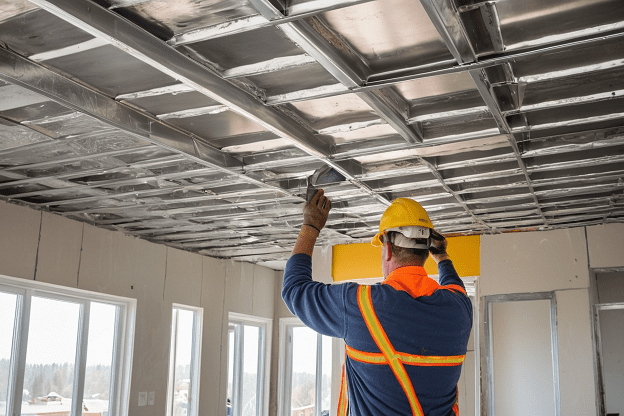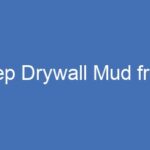Hanging drywall with a cordless screwdriver has become a popular and efficient method in modern construction and home improvement projects. The use of cordless screwdrivers simplifies the installation process, offering increased mobility and flexibility on the job site. With their lightweight and portable design, these power tools enable contractors and DIY enthusiasts to move seamlessly throughout the space, driving screws into the drywall with precision and speed.
The cordless convenience eliminates the need for cumbersome cords and allows for quick adjustments, making the installation of drywall more streamlined and less labor-intensive. This approach not only enhances productivity but also contributes to a smoother and more professional finish in wall construction, showcasing the practicality and effectiveness of integrating cordless screwdrivers into the drywall installation process.
Most drywall hangers use drywall screw guns to install gypsum panels. These tools are essentially electric drills with added features that make them ideal for drywall installation. If you lack a screw gun, a cordless drill can be used for this purpose. However, it’s essential to be familiar with critical drywall hanging techniques, especially the depth of screw heads.
Do not allow the screw head to penetrate the paper layer. Drywall consists of compressed gypsum sandwiched between two thin paper sheets. The paper adds strength to the gypsum, but the gypsum itself is delicate. When a screw or nail applies force to the paper surface, it distributes some of this force across the gypsum underneath, securing the drywall to the wall. If the screw or nail head punctures the paper and directly contacts the gypsum, it loses its gripping ability because the gypsum crumbles under the pressure of the fastener.
Think of an ice cream sandwich as a simple yet helpful analogy. The whole sandwich is supported by the surrounding graham cracker layers, with the ice cream having little inherent strength. Your ability to hold the ice cream sandwich between your fingers is primarily due to the strength of the cookie layers, which distribute pressure evenly over the ice cream layer’s surface.
If a screw head punctures the paper layer, it causes slight movement in the drywall, leading to what is known as “screw pops,” a term referring to imperfections in the painted surface of drywall. These imperfections are often wrongly attributed to drywall finishers or painters, but their root cause lies in the techniques employed during drywall installation.



With this in mind, using a cordless screw gun requires extreme caution when sinking screws into drywall. Screws should be sunk deep enough that a drywall knife can skim over them without touching. Even a slight protrusion of a screw is known as a “clicker” because it emits a “click” when scraped with a drywall knife. While screws should not be left above the drywall paper’s surface, the screw head should also avoid completely puncturing the paper, as it loses all gripping power in that case and should either be removed or secured with screws above and below.
There are drill bit accessories that include a built-in guard, known as drywall screw setters or dimplers. These dimplers are designed to prevent the screw from sinking too deeply into the drywall. The guard contacts the paper and halts the Phillips head screw bit from driving the screw any further into the board.
Choosing a Drywall Screw Dimpler
Several options for screw dimplers are available in the market and are sometimes referred to as screw setters.
Molded Screw Dimpler or Screw Setter
The more affordable screw setters have a guard welded or molded onto the Phillips head screw bit. Since the guard is integrated with the bit, it spins at the same rate as the bit. When the dimpler guard makes contact with the drywall paper, it can dig in or scuff the paper’s surface, potentially causing the drywall to tear away. This can present challenges for drywall finishers during the finishing process, especially in smooth wall applications where torn paper can be visible after painting.
Spring Loaded Clutch Release Screw Dimpler
The second type of drywall screw setters or dimplers are spring-loaded and include a clutch release that reduces drywall tear-out. When pressure is applied to the Phillips head bit, the clutch engages, allowing the bit to spin and drive the screw. Unlike the guard, the dimpler’s guard remains stationary, reducing the risk of drywall tear-out. Once the Phillips head bit reaches the proper depth, the clutch disengages, preventing further screw penetration. Some clutch release screw dimplers also offer adjustable depth guides, which should be used while keeping the principles of screw head depth in mind.



Using a Drywall Screw Gun
Drywall screw guns are the optimal choice for hanging drywall when using drywall screws as fasteners. These specialized electric drills come with features designed specifically for drywall. They typically operate at an RPM rate ranging from 5800 to 6000, which is higher than that of general-purpose electric drills. They feature a switch located near the trigger switch, allowing the operator to lock the drill in the “on” position, reducing trigger finger fatigue. The most crucial feature is an adjustable depth guard, as proper screw depth is essential, as explained above.
You can find quality drywall screw guns at most large retail stores or many online retailers. The average cost of a new gun is around $90.00 to $100.00, and some places offer special deals, such as selling two screw guns for the price of one. For small DIY projects, a screw dimpler can suffice alongside your cordless drill.
However, for slightly larger projects, consider searching for affordable drywall screw guns, which may be available for around $50.00. Keep in mind that using a screw gun has a learning curve, so if you are not willing to invest the time to become familiar with it, you may opt for a screw dimpler or professional assistance.
What size screw bit is used for drywall screws? Drywall screws typically have a standard head size, requiring a number 2 screw bit for installation. The mentioned screw dimplers should come with this size screw bit. Drywall screw guns are usually sold with a number 2 screw bit, and it’s wise to have replacement screw bits on hand for extended use due to eventual wear and tear.
Wrapping Up
Indeed, you can use a cordless drill for installing drywall, but professionals prefer using a drywall screw gun. Regardless of the method chosen, the key factor to remember when sinking screws into drywall is the depth of the screw head. Screw dimplers can be a valuable tool to ensure the correct screw depth.
tag: # Hanging Drywall with a Cordless Screwdriver







